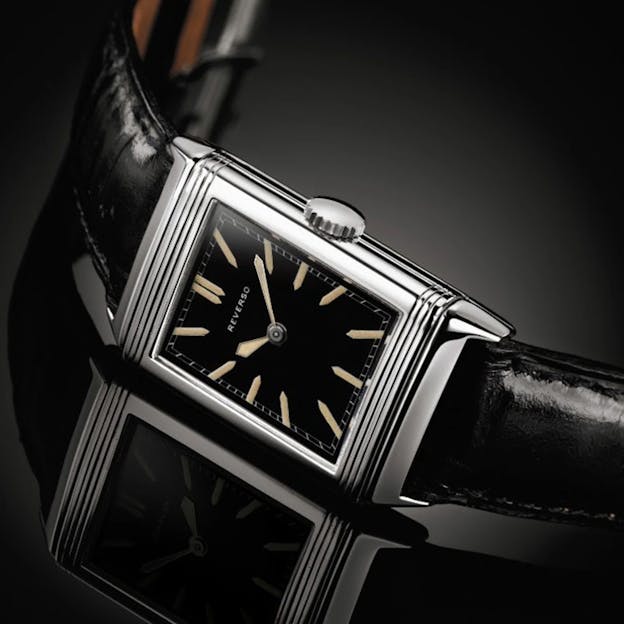Highs and Lows: Jaeger-LeCoultre’s Ride from Aston Martin to the Stars
From an Aston Martin–inspired alarm watch to a Reverso that packs the entire cosmos, we’re diving into JLC’s range from accessible to audacious.
Welcome back to another installment of High and Low – The column where we explore the full range of a brand’s catalog, from its most affordable to its highest-priced pieces, from both our pre-owned and new offerings.
For this week we’re focusing on Jaeger-LeCoultre, a brand name I refuse to say out loud on video out of pure fear of mispronunciation and the kind of ridicule that would make even Bruce Bogtrotter feel sorry for me.
Jaeger-LeCoultre: A Household Name in Watchmaking

Jaeger-LeCoultre really needs no introduction. Their story kicks off in 1833, tucked away in Switzerland’s famed Vallée de Joux, when Antoine LeCoultre set up shop with the simple idea of making watches as precise as humanly possible. He wasn’t just tinkering with gears; the man was inventing. He came up with the Millionometer in 1844, which could measure down to a micron, and then followed it up with a keyless winding system in 1847. Basically, if it had to do with pushing watchmaking forward, LeCoultre was the guy behind it.
Fast forward a few generations, and the LeCoultre family linked up with Edmond Jaeger, a Parisian watchmaker who specialized in impossibly thin movements including the caliber 145, measuring 1.38mm and produced in 1907. Their collaboration eventually became official in 1937 under the name Jaeger-LeCoultre, but even before that they were making waves together with icons like the Reverso, launched in 1931, which was born out of polo players asking for a watch they could flip over mid-match to protect the dial.

Since then, JLC has been known as “the watchmaker’s watchmaker,” supplying movements to heavy hitters like Patek Philippe, Audemars Piguet, and Vacheron Constantin, all while building its own legendary timepieces. From the Atmos clock that runs on air pressure changes to ultra-complicated pieces that still blow minds today, the brand has racked up over 1,200 calibers and counting. Whether you’re drawn to the understated Master Control, the sporty Polaris, or the enduring cool of the Reverso, JLC has always been that rare mix of technical innovation and style. And for me, they are one of my all-time favorite brands.
In a side note you did not ask for — if you are looking for one of the best vintage buys out there it’s the Jaeger-LeCoultre Powerwind Ref E 373 with Breguet numerals and power reserve. (The ref E 372 is another gem as well — Happy Hunting!)
The Low: Amvox 1 Aston Martin Special Edition Ref. Q1908470

During the roaring 1920s, cars weren’t just about getting from A to B, they were about glamour, speed, and a little bit of danger. Fresh off the innovations of World War I, LeCoultre & Cie joined forces with Edmond Jaeger to kit out dashboards and counters. If you were sitting behind the wheel of an Aston Martin LM in the 1930s, chances are the instruments staring back at you were stamped with a simple “Jaeger.” By then, LeCoultre & Cie was so embedded in racing that their speedometers showed up in about 95 percent of winning cars. Not bad for a watchmaker moonlighting in motorsport.
Jump to 2003, Aston Martin’s 90th birthday. The two names reunited officially, long before watch–car tie-ins became the marketing machine they are today. Aston was looking to boost its visibility in a new millennium, and Jaeger-LeCoultre had history, credibility, and plenty of mechanical muscle to back it up. The match made sense: one builds some of the most elegant sports cars ever made, the other builds movements that everyone else borrows from.

The very first press kit simply called the collaboration the “Aston Martin Jaeger-LeCoultre Edition.” But a name with more punch was inevitable. Enter the Amvox, a mashup of Aston Martin’s initials and “Memovox,” the JLC alarm watch that inspired the design. It’s like the Bennifer for luxury items. The Amvox 1 officially launched in 2005, the same year the original Memovox turned 40.
When this watch came out, the official Polaris tribute models hadn’t been released yet, which is why it feels so much like a modern revival of the 1968 Polaris. The triple-crown layout is straight out of that playbook: the center crown controls the rotating internal bezel, the top crown sets and winds the alarm, and the bottom crown handles the hacking seconds. Inside is the caliber 918, an automatic movement that traces its lineage back to the late ’60s caliber 916. It doesn’t have a true quickset, but what it does have is character.
The case measures 42 mm, with the standard version in stainless steel paired to a black dial, and a limited run of 750 pieces in titanium with a ruthenium-grey dial. The sapphire crystal is dramatically boxed, a design cue inspired by Aston Martin speedometers. And then there’s the alarm: the 14 perforations in the caseback let the sound resonate loudly, while a free-hanging gong makes it punchier than earlier Memovox models. The whole thing is powered by an automatic bi-directional rotor.
Lume is everywhere you’d want it to be, making the watch fully functional in low light. Official production ran from 2004 to 2010, and in many ways this model bridged the proverbial gap, carrying the DNA of the late-’60s Polaris while setting the stage for the full-blown modern tributes that would follow.
The High: Reverso Grande Complication à Triptyque Limited Edition

When it comes to writing about this watch, I have the luxury of leaning on a previous piece by Jack. To be honest, there isn’t much I can add to the watch, its story, or everything surrounding it that he hasn’t already covered in his comprehensive write-up. That said, I’ll share a few special details here, but I highly recommend digging into his piece for the full deep dive.
Unveiled at SIHH in 2006 to celebrate Jaeger LeCoultre’s 75th anniversary, the Grande Complication à Triptyque remains one of the brand’s boldest creations. Before even getting into the details I need to state from the jump that this watch is large. It’s big, heavy and in no way is a daily wear kind of piece. That said, for how much they pack into this watch, the dimensions aren’t that insane. At 34.5mm across, 18mm thick, and 54.5mm lug to lug, it’s definitely wearable, but it’s definitely not something that will tuck quietly away under the cuff.
I think “audacious” captures this watch perfectly. Its creation was an act of intrepid audacity, an adventurous attempt to take the celestial world and shrink it down onto the wrist.

The front dial displays standard civil time, paired with a subtle day/night indicator, a discreet power reserve tucked in the upper left, and a massive one-minute tourbillon occupying the lower left. The tourbillon cage itself has a manta ray–like form and doubles as the running seconds. Hidden beneath the carriage is something even more unusual, JLC’s own Ellipse Isometer Escapement, a proprietary invention.

Enact that classic Reverso move and flip the case over (about the only thing this watch has in common with a traditional Reverso) and the second dial is devoted entirely to astronomy. Here, Jaeger LeCoultre loaded the watch with a full suite (a cornucopia if we will) of celestial complications, turning the reverse face into a miniature planetarium. As someone whose knowledge of the night sky mostly comes from lying in a field at summer camp, I can say that even without fully grasping every complication on display, the watch is absolutely stunning. Visually, it is about as pleasing to the eye as a complicated watch design can get.
Jack described the second face best when he said, “This is where things start to get downright romantic, at least if you find celestial complications evocative of the spirit of harmony in the heavens that we used to call the music of the spheres.”
You have two main hands running the show. The silver one tracks sidereal time, basically “star time,” which is how long it takes a fixed star to show up in the same spot in the sky. Then there is the hand tipped with a little sun, and that is your Equation of Time. In short, it tells you the difference between the neat and tidy 24 hour day we live by and the messy reality of how the Earth actually moves.

Thanks to our tilted axis and slightly off orbit, a solar day can run about fifteen minutes fast or slow depending on the time of year. Back in the day, that difference mattered so much that clockmakers used to paste Equation of Time tables inside pendulum clocks to keep them honest.
And that is just the start. There is a planispheric star chart on the dial that shows you exactly what constellations are overhead at any given time, plus indicators for sunrise and sunset tucked neatly to the sides. Put it all together and this dial is not just a complication, it is basically a pocket planetarium, a full on model of Earth’s relationship with the Sun, right there on your wrist.
And if that somehow wasn’t enough, there’s a third face. Yes, a third face. Sorry Batman villain fans, this one’s got you beat. JLC tucked a full perpetual calendar with moonphase into the case carrier itself, a first for the brand. The movement comes in at a mind-bending 1.7mm thick, which is honestly the only thing that keeps this beast remotely wearable.

